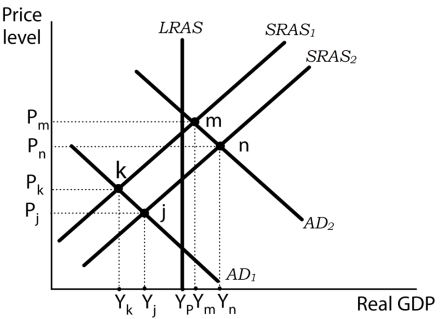Use the following to answer questions .
Exhibit: Aggregate Demand and Aggregate Supply and the Great Depression 
-(Exhibit: Aggregate Demand and Aggregate Supply and the Great Depression) During the Great Depression, aggregate demand declined sharply, thrusting the economy into a recessionary gap. Nominal wages plunged roughly 20% between 1929 and 1933. How did the economy respond to the falling wages?
A) The short-run aggregate supply curve shifted left, from SRAS2 to SRAS1, resulting in a short run equilibrium at point k.
B) The short-run aggregate supply curve shifted right, from SRAS1 to SRAS2, resulting in a short run equilibrium at point n.
C) The short-run aggregate supply curve shifted right, from SRAS1 to SRAS2, resulting in a short run equilibrium at point j.
D) The short-run aggregate supply curve shifted left, from SRAS2 to SRAS1, resulting in a short run equilibrium at point m.
Correct Answer:
Verified
Q19: Who was the economist who laid the
Q21: Keynes believed that wages and prices were
Q22: Use the following to answer questions .
Exhibit:
Q23: Keynes's theory of macroeconomics rejects classical macroeconomists'
Q25: Keynes argued that the surest way to
Q26: Use the following to answer questions .
Exhibit:
Q27: According to Keynesian theory,
A) sticky prices and
Q28: Use the following to answer questions .
Exhibit:
Q29: The Smoot-Hawley Tariff Act of 1930 contributed
Q48: The General Theory of Employment, Interest, and
Unlock this Answer For Free Now!
View this answer and more for free by performing one of the following actions

Scan the QR code to install the App and get 2 free unlocks

Unlock quizzes for free by uploading documents